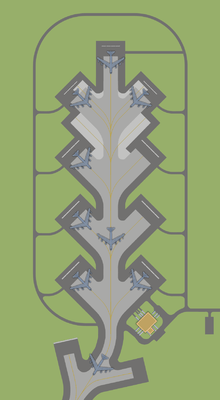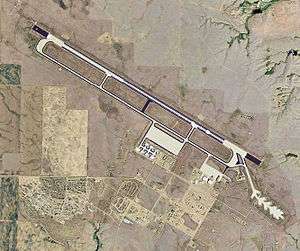Glasgow Air Force Base
Glasgow Air Force Base  | |
|---|---|
| Part of Strategic Air Command/Air Defense Command | |
| St. Marie, Valley County, near Glasgow, Montana | |
|
USGS aerial photo as of 2006. Note the "Christmas tree" at bottom right. | |
 Glasgow AFB | |
| Coordinates | 48°25′16″N 106°31′40″W / 48.42111°N 106.52778°W |
| Type | Air Force Base |
| Site history | |
| Built | 1957 |
| In use |
1957-1968 1971-1976 |

_is_refueled_by_Boeing_KC-135A-BN_(SN_55-3127)_061127-F-1234S-009.jpg)
- For the civil use of this facility and airport information, see Glasgow Industrial Airport
Glasgow Air Force Base (GAFB, former ICAO: KGSG; 1957–1968, 1971–1976) is a former United States Air Force base located approximately 17 miles (27 km) north of the city of Glasgow, Valley County, Montana, not far from the Canada–US border. Prior to DoD ownership, 605 acres (245 ha) of this land were used as a municipal airport and the rest for agricultural purposes.
Today the facility is all but unused, being known as Glasgow Industrial Airport (FAA LID: 07MT) which had 30 aircraft landings/takeoffs in 1991.[1] In recent years, the former Air Force Base has seen intermittent use as a testing site for Boeing aircraft designs. The former base housing area is now the residential community of St. Marie, Montana, though most of the buildings remain vacant.
History
Construction of the base began in 1955, and GAFB was activated in 1957 as part of Air Defense Command (ADC). It was activated in 1957 as a base for Air Defense Command interceptors, which initially operated from a single 8,900' runway.
Glasgow was the home of the ADC 476th Fighter Group from 1957 to 1960, and the 13th Fighter Interceptor Squadron from 1959 to 1968, which were equipped with the F-101 Voodoo.
The base was transferred to the Strategic Air Command (SAC) in 1960. With the transfer, the runway was significantly expanded to 13,500' in length, to support the coming operation of Boeing B-52 bombers and Boeing KC-135 tankers.
In February 1961, the 326th Bombardment Squadron, equipped with B-52C aircraft, was reassigned to the base from Fairchild AFB, Washington, as the nucleus for the organization of the 4141st Strategic Wing. In its first year, this became the top wing in Fifteenth Air Force.
The 4141st Strategic Wing inactivated at Glasgow AFB on February 1, 1963 and its B-52C aircraft were transferred to the 322nd Bombardment Squadron, 91st Bombardment Wing, which has stood up at Glasgow AFB to train for global bombardment and aerial refueling. The wing also received and converted to B-52D aircraft and its 907th Air Refueling Squadron received KC-135A aircraft.
Except for a small rear echelon, the 91st Wing headquarters staff, tactical aircraft and 322d Bomb Squadron crews, and most support personnel integrated in the Strategic Air Command B-52D Arc Light force for combat in Southeast Asia during the Vietnam War.
With the pending closure of Glasgow, the 91st was taken off alert status and declared not tactically operational May–June 1968. The wing was subsequently inactivated on June 25, 1968 and became the 91st Strategic Missile Wing, operating Minuteman III intercontinental ballistic missiles at Minot AFB, North Dakota.
1968 closure
When the base closed in 1968, 16,000 people left the Glasgow area, a trend that continued among the civilian population. In 1970, Glasgow had an emigration rate of 33 percent; in 1980 the population fell to 4,500, and it was expected to fall below 4,000 in 1990.
1970s USAF use
Glasgow AFB was reactivated as a SAC dispersal base from 1971 to 1976, and was also used as an Army Safeguard ABM depot supporting construction of a second ABM complex northwest of Malmstrom AFB, Montana which was not completed. When Glasgow AFB ceased all USAF activities in 1976, it was so isolated and without business advantages that it sat idle for years until the Boeing Company began testing aircraft there and new houses were being rebuilt and sold, without the use of asbestos, being that it was deemed unstable and unusable. All use of asbestos was stopped and was not put to use within the new houses of the new re-build houses in the air base.
Post military use
In February 1997, then-Senator Conrad Burns (R-MT) announced that he had helped set up negotiations between the Saint Marie Condominium Association (SMCA) and Boeing regarding the possible lease of the officers club on the old Glasgow Air Force Base. With the exception of the Glasgow Industrial Airport located in Glasgow, Montana, which is company-owned, runways and taxiways used by Boeing are located on airport properties owned by others and are used by the company jointly with others.
The Boeing Company continues to own most of the former Glasgow AFB and it is now known as the Boeing Glasgow Flight Test Facility. The facility supports Boeing Technology Services (BTS) customers and is maintained and operated by Montana Aviation Research Company (MARCO), a subsidiary of The Boeing Company.[2]
Major commands to which assigned
- Air Defense Command, February 8, 1957 – April 1, 1960
- Remained as tenant unit until June 30, 1968
- Central Air Defense Force, July 2, 1959
- 29th Air Division (Defense), April 1, 1960
- Minot Air Defense Sector, January 1, 1961 – June 30, 1968
- Strategic Air Command, April 1, 1960 – June 30, 1968; September 30, 1971 – September 30, 1976
- Fifteenth Air Force
- 810th Strategic Aerospace Division, July 1, 1962 – July 1, 1963; July 1, 1966 – June 30, 1968
- 18th Strategic Aerospace Division, July 1, 1963 – September 1, 1964
- 821st Strategic Aerospace Division, February 15, 1962 – July 1, 1962; September 1, 1964 – July 1, 1966
Major units assigned

- 476th Fighter Group (Defense), February 8, 1957 – June 30, 1968
- Not equipped, February 8, 1957 – July 2, 1959
- 13th Fighter-Interceptor Squadron, July 2, 1959 – June 30, 1968 (F-101B)
- 4141st Strategic Wing, September 1, 1958 – February 1, 1963
- Not equipped, September 1, 1958 – February 1, 1961
- 326th Bombardment Squadron, February 1, 1961 – February 1, 1963 (B-52C)
- 91st Bombardment Wing November 18, 1962 – June 30, 1968
- 322d Bombardment Squadron, February 1, 1963 – June 25, 1968 (B-52C/D)
- Detached to Advanced Echelon, 3d Air Division: September 11, 1966 – March 31, 1967; February 16 – April 30, 1968
- (Deployed to Andersen AFB, Guam for Arc Light Missions)
- Not Operational: May 1 – June 25, 1968
- 907th Air Refueling Squadron, July 1, 1963 – June 25, 1968 (KC-135A)
- Detached to Advanced Echelon, 3d Air Division: September 11, 1966 – March 31, 1967; February 5 – April 16, 1968
- (Deployed to Andersen AFB, Guam)
- Not Operational: May 1 – June 25, 1968
- 4300th Air Base Squadron, November 17, 1971 – September 30, 1976
- Detached from Fairchild AFB, Washington for dispersed B-52/KC-135 Operations
Note: All aircraft deployed to Fairchild AFB, Washington April 1 – June 30, 1964 due to runway repairs[3]
References for commands and major units assigned:[4][5][6][7][8]
See also
References
Notes
- ↑ FAA Airport Master Record for 07MT (Form 5010 PDF), effective 2008-04-10
- ↑ Aviation Week and Space Technology, October 8, 2012, pp. 44-45
- ↑ USAFHRA Document 00452344
- ↑ Ravenstein, Charles A. (1984). Air Force Combat Wings Lineage and Honors Histories 1947–1977. Maxwell AFB, Alabama: Office of Air Force History. ISBN 0-912799-12-9
- ↑ USAF Aerospace Defense Command publication, The Interceptor, January 1979 (Volume 21, Number 1)
- ↑ Maurer, Maurer, ed. (1982) [1969]. Combat Squadrons of the Air Force, World War II (PDF) (reprint ed.). Washington, DC: Office of Air Force History. ISBN 0-405-12194-6. LCCN 70605402. OCLC 72556.
- ↑ USAFHRA Document 01020821
- ↑ USAFHRA Document 00900080
Sources
![]() This article incorporates public domain material from the Air Force Historical Research Agency website http://www.afhra.af.mil/.
This article incorporates public domain material from the Air Force Historical Research Agency website http://www.afhra.af.mil/.
- Ravenstein, Charles A. Air Force Combat Wings Lineage and Honors Histories 1947–1977. Maxwell Air Force Base, Alabama: Office of Air Force History 1984. ISBN 0-912799-12-9.
- SAC Bases: Glasgow Air Force Base
- Boeing Technical Services - Flight Test Facility
- Abandoned & Little-Known Airfields: Glasgow AFB, Montana

